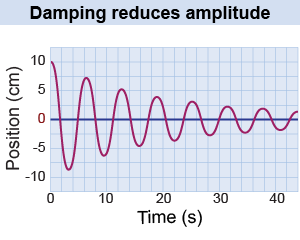|
Most oscillators have a resting state, or equilibrium position. At equilibrium the net force is zero. A system in equilibrium remains in equilibrium until some outside force disturbs it. Any force that disturbs the system’s equilibrium adds energy and the added energy is what causes the oscillations. The energy in the oscillations is therefore additional to any energy the system has in equilibrium. 
|
The amplitude describes how far an oscillator moves away from equilibrium during each cycle. Amplitude is measured in units that match the oscillation. For a mass on a spring, the amplitude is the maximum distance the mass moves up or down away from its equilibrium position. With other oscillators the amplitude might be a voltage or a pressure. The key idea is that amplitude always describes the maximum displacement from equilibrium. This is usually half the distance from the highest to the lowest point. Notice that positive and negative values are used to represent motion on either side of equilibrium. The graph in the figure shows the mass on the spring moving between +10 cm and −10 cm, and thus with an amplitude of 10 cm. 
|

|
Harmonic motion involves energy that oscillates among different forms. Consider the mass on the spring. The system has kinetic energy because there is moving mass. The system also has elastic potential energy because the oscillation stretches a spring. The kinetic energy is largest when the mass moves through the equilibrium position. This is when its speed is greatest, before the force from the spring starts to slow it down again. The system has the most elastic potential energy when it reaches the highest or lowest point in its cycle, when its kinetic energy is zero. All the kinetic energy has been converted to elastic potential energy at these points. The continuous transformation of energy back and forth between two or more forms is a characteristic of most oscillators. 
|
 Friction converts kinetic energy into heat and wear. As the energy of an oscillator decreases from friction, the amplitude decreases. The frictional decrease in amplitude is called damping. Over time, damping reduces the speed of an oscillating mass on a spring until it gradually comes to a stop. The graph of position versus time (on the right) shows the reduction of amplitude over many cycles owing to damping. In most situations, even though the amplitude decreases, the frequency stays the same. The peaks on the graph occur at the same time intervals.
Friction converts kinetic energy into heat and wear. As the energy of an oscillator decreases from friction, the amplitude decreases. The frictional decrease in amplitude is called damping. Over time, damping reduces the speed of an oscillating mass on a spring until it gradually comes to a stop. The graph of position versus time (on the right) shows the reduction of amplitude over many cycles owing to damping. In most situations, even though the amplitude decreases, the frequency stays the same. The peaks on the graph occur at the same time intervals. 
|
The amplitude of a mass oscillating on a spring is 20 cm. How far apart are the highest and lowest points? - 0.05 cm
- 10 cm
- 20 cm
- 40 cm
 |
The correct answer is d. The amplitude is half the distance from the highest to the lowest point, so twice the amplitude is the distance from the highest to the lowest point. Twice 20 cm is 40 cm. 
|

